Key Points:
- Energy, in the form of electrons, flows from food to oxygen.
- Resistance to the flow of energy allows for life to exist, but too much resistance promotes aging.
- Lowering energy resistance, such as by boosting NAD+, may mitigate cellular dysfunction and age-related conditions.
In defiance of entropy, we exist in a highly ordered physical state known as the human body. To persist, we must consume food and breathe oxygen, providing the primary substrates necessary for the flow of energy. As this flow of energy sustains life, when disrupted, it promotes aging and death. However, according to the energy resistance principle, contrived by Dr. Martin Picard of Columbia University and Dr. Nirosha Murugan of Tufts University, flow is (literally) only one part of the equation.
Energy Flows from Food to Oxygen
The flow of energy, in the form of electrons, begins with the food we consume. After digestion, nutrients are absorbed into the bloodstream and transported into our cells. Once in our cells, the nutrients are metabolized into simpler molecules that can be shuttled into mitochondria, where they are metabolized further. Within mitochondria, the breakdown of nutrients releases electrons that are captured by NAD+ (which then becomes NADH) and carried to the electron transport chain (ETC).
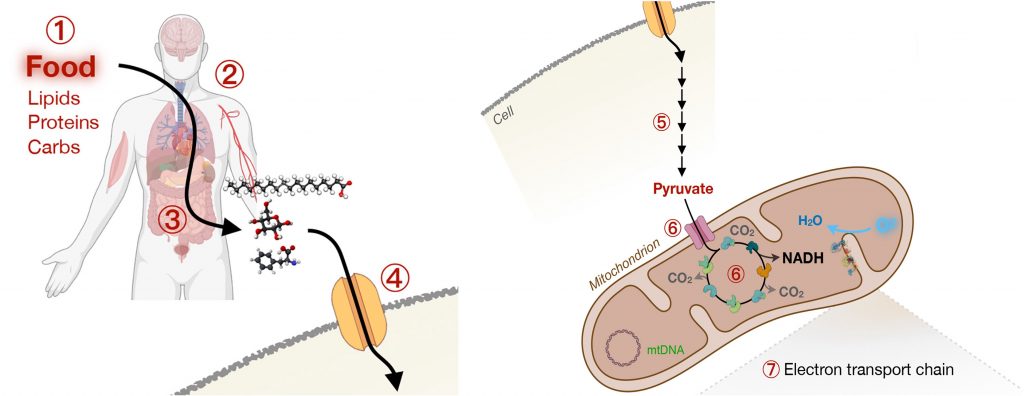
Upon transferring an electron to the ETC, NADH becomes NAD+ again. The electron then moves through the ETC, releasing protons on one side of the membrane until it reacts with oxygen to form water and CO2. As more electrons are transferred and passed through the ETC, they accumulate on one side of the membrane. The protons can only cross the membrane through a large enzyme called ATP synthase, and the capacity to do so occurs only when a type of potential energy called protonmotive force becomes large enough. This force pushes the protons through ATP synthase, which synthesizes ATP (adenosine triphosphate).
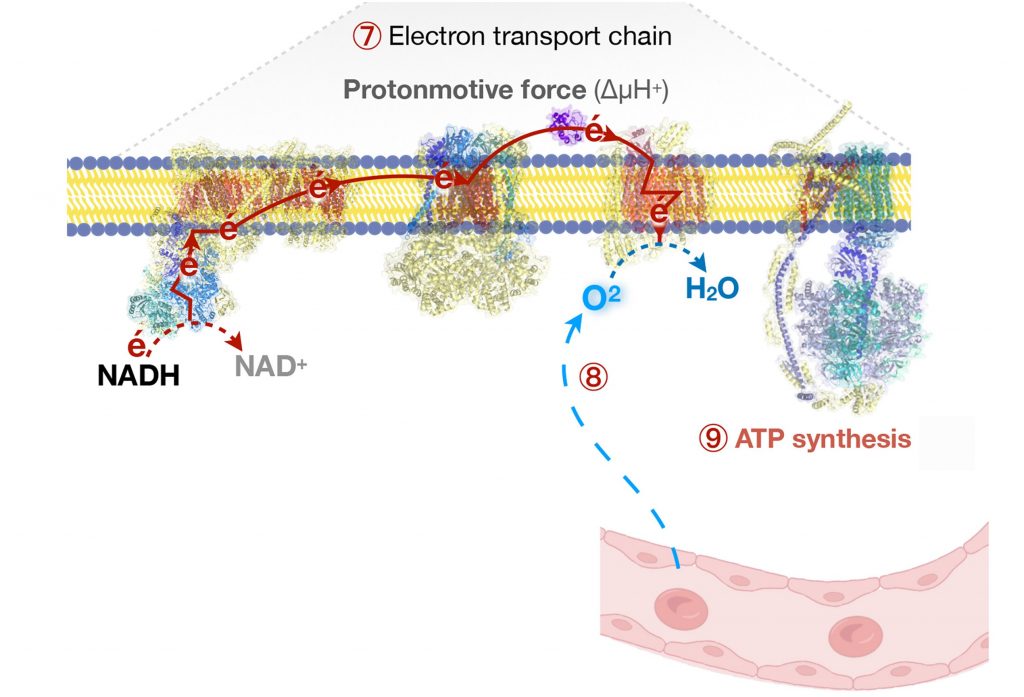
ATP is the primary energy-storing molecule in our body that our cells can access and use to operate and survive. Thus, energy flows from food to oxygen while changing forms. Food contains energy in the form of chemical bonds (chemical energy), which are broken to generate electrons (electrical energy), which then generate a protonmotive force (potential energy). In turn, this potential energy is harnessed to form new chemical bonds that can readily be utilized by cells (ATP).
The Whole Equation and the Basis for Aging
The flow of energy (f), described above, is only one part of the equation. According to the energy resistance principle (ERP), resistance to the flow of energy (éR) is the basis for energy transformation and life. In the human body, energy resistance, éR, comes in the form of biophysical constraints such as enzymatic reactions and the ETC. Only with these structural constraints can the flow of energy, f, be used to do biological work. Without resistance, éR, the food we consume would not be made into ATP, as described above, but would be dissipated as heat.
Moreover, for the highly ordered system (human body) to persist, energy must be expended, and this creates an energy demand, or an energy potential (EP). Factors that lower energy demand, EP, include different forms of rest and relaxation, such as sleep and meditation, as well as fasting and caloric restriction (consuming fewer calories), the latter two of which are known to prolong the lifespan of animals. Factors that increase energy demand, EP, include stress, high blood sugar, cell proliferation (e.g., cancer), and infection.
Energy demand, EP, is related to energy resistance, éR, and the flow of energy (f) by the equation, éR = EP/f2. According to this equation, changes in energy flow, f, lead to disproportionally larger effects on energy resistance, éR, than energy demand, EP, because energy flow increases exponentially. Moreover, the equation states that more energy flow, f, and less energy demand, EP, lower energy resistance, éR. This is critical because this equation forms the basis of the ERP, where aging and age-related diseases could be mitigated by lowering energy resistance, éR.
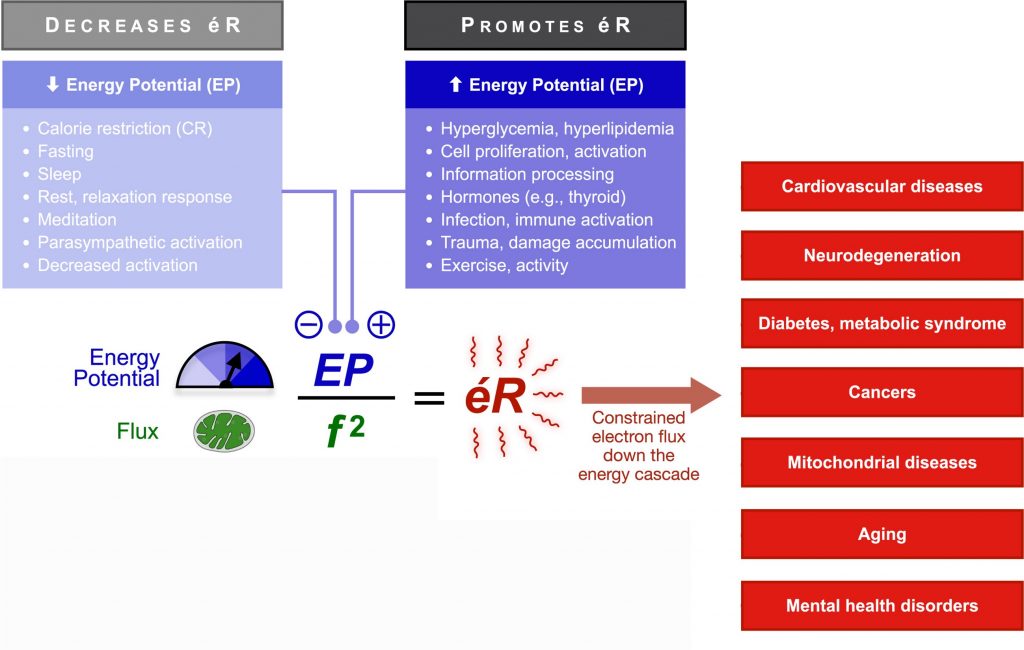
How Too Much Energy Resistance, éR, Can Lead to Aging
Resistance, éR, allows for the transformation of energy flow, f, that sustains life. However, too much energy resistance, éR, can lead to damage. For example, when mitochondria become damaged and/or overloaded with electrons from the excess consumption of food, electrons can no longer efficiently flow through the ETC. When this occurs, the electrons backflow to NAD+, converting it back to NADH. This results in an increase in the NADH/NAD+ ratio, which is a state called reductive stress.
As a consequence of reductive stress, the ETC starts to leak electrons that react with oxygen to generate reactive oxygen species (ROS). Low levels of ROS can be neutralized by antioxidants, but excessive levels begin to damage the molecular components of cells. Mitochondria, the trillions of living resistors in our body that produce ATP, are the primary source of ROS. This means that damaged mitochondria, which exist in nearly every cell of the body, can lead to a massive increase in energy resistance, éR, triggering the reductive and oxidative stress that promotes aging and age-related diseases.
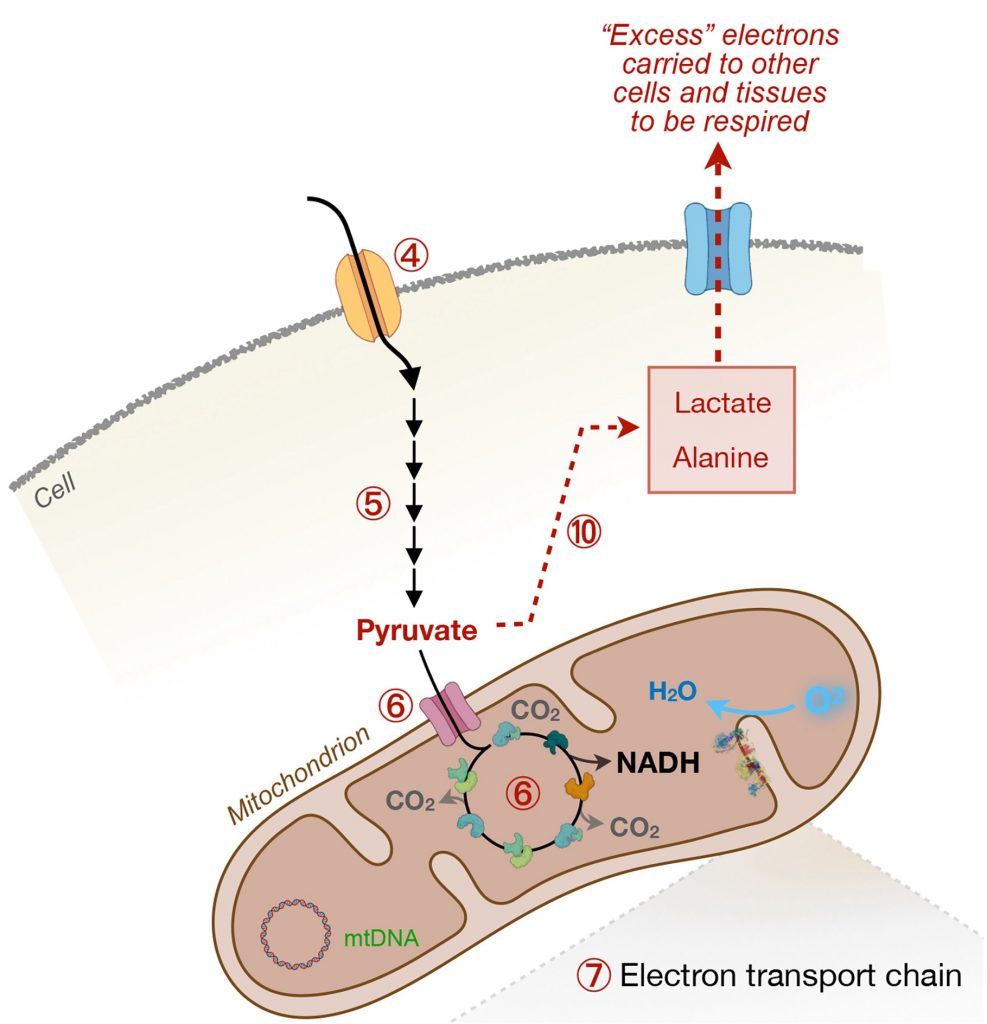
Moreover, the increase in the NADH/NAD+ ratio and excessive levels of ROS act as signaling molecules that stimulate stress responses. These responses drive age-promoting processes such as programmed cell death (apoptosis) and cellular senescence. The stress response also activates the secretion of signaling proteins called cytokines, which travel through the bloodstream to affect the entire body. This “cytokine storm” is referred to as inflammation. A notable cytokine, called GDF15, acts on the brain and is associated with malaise, nausea and fasting, social isolation, and depression.
Enhancing Energy Flow with NAD+ to Combat Aging
When it comes to reducing energy resistance, éR, to mitigate cellular damage and aging, increasing energy flow, f, has a much larger effect than lowering energy demand, EP. Factors that enhance energy flow, f, include the production of new mitochondria (mitochondrial biogenesis) and formation of new blood vessels (angiogenesis), which are adaptations that can be induced by regular exercise. Ketosis, induced by fasting or eating a diet lacking carbohydrates, may also increase energy flow, f. Moreover, boosting NAD+ with precursors like NR (nicotinamide riboside), NMN (nicotinamide mononucleotide), or nicotinamide may also increase energy flow, f.
Considering the effects of increasing flow, f, it follows that lowering it has a relatively more profound effect on increasing energy resistance, éR, and susceptibility to aging than lowering energy demand, EP. Factors that reduce energy flow, f, include mitochondrial DNA (mtDNA) defects, toxins, cytokine signaling, and tissue scarring (fibrosis). These factors overly constrain the flow of energy, f, leading to cellular hallmarks of disease.
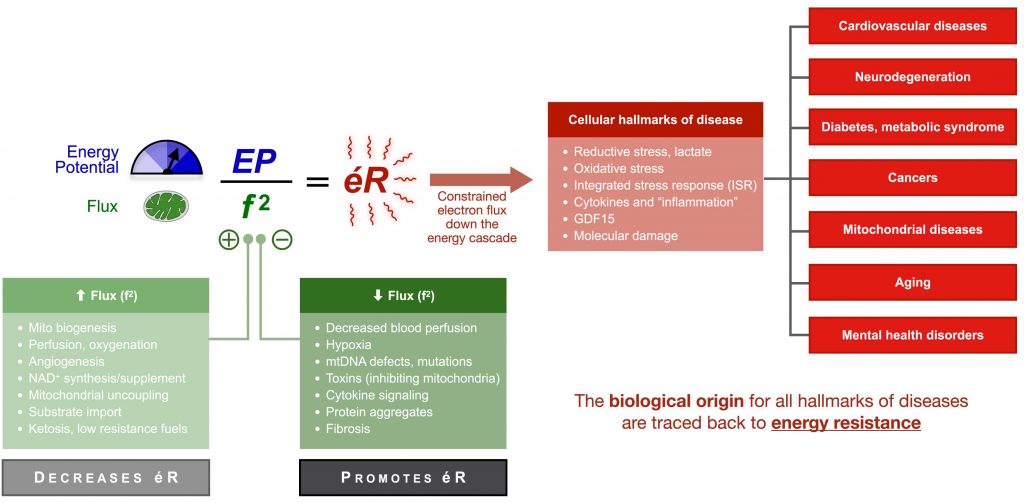
The ERP explains how the body transforms energy to sustain life. It also explains how blocking energy flow, in the form of resistance, can lead to cellular dysfunction and age-related conditions. This framework is compatible with scientific evidence showing that interventions such as fasting, NAD+ supplementation, and exercise can support the prevention or delay of said cellular dysfunction and age-related conditions. Dr. Picard and Dr. Murugan conclude,
“Energy is the largely missing dimension of biomedicine. The ERP offers a general, testable framework to bridge physics and biology and to understand the role of energy across various domains of life, including human health, disease, and the experiences that define the human condition.”